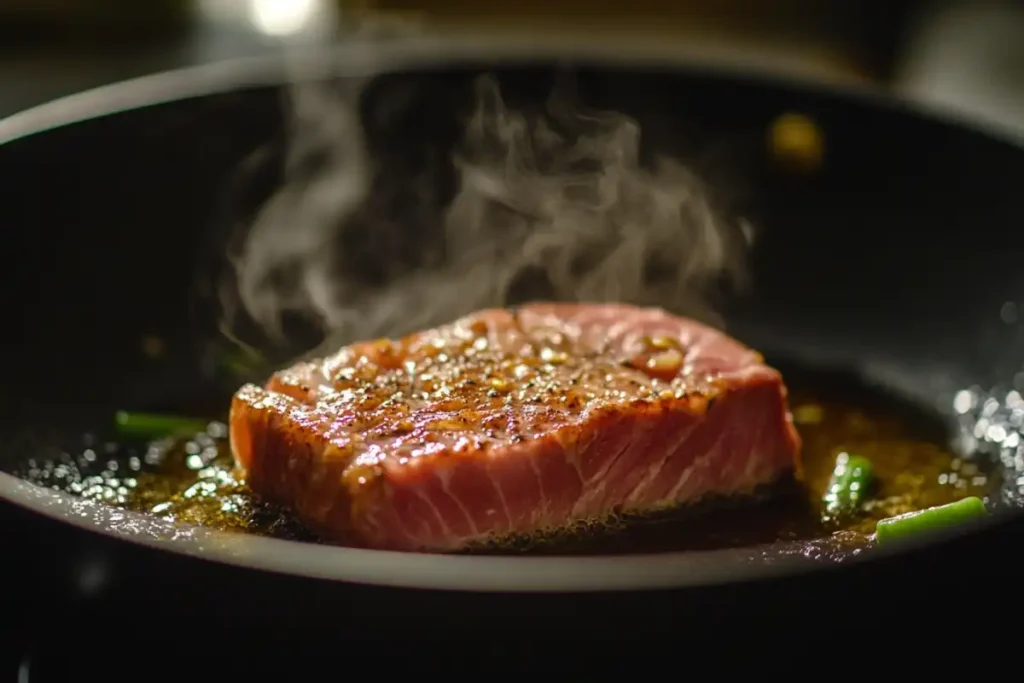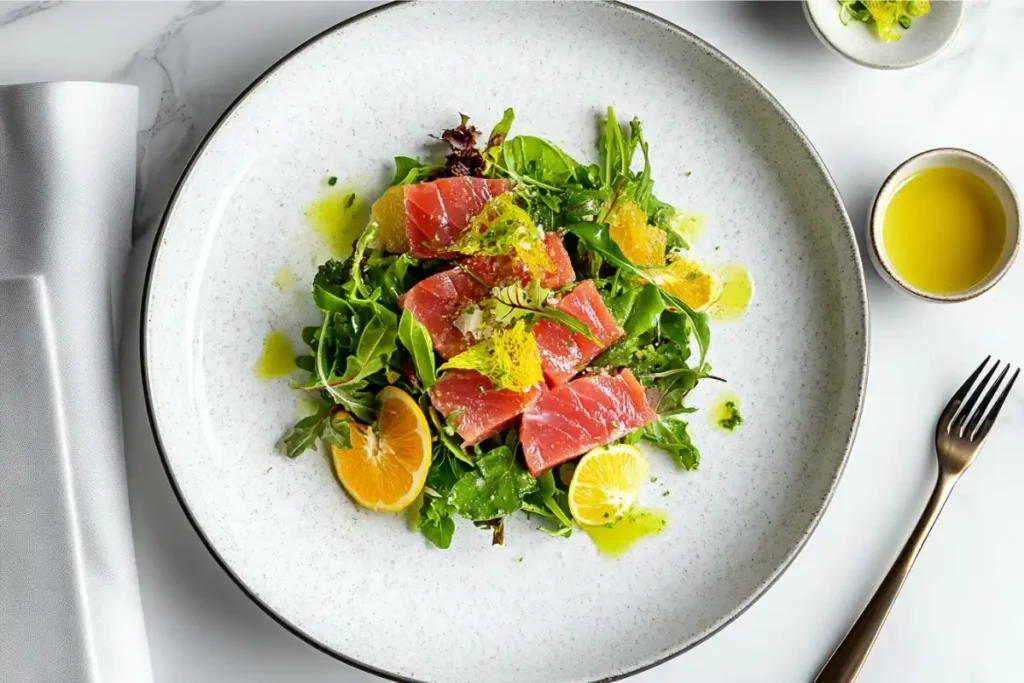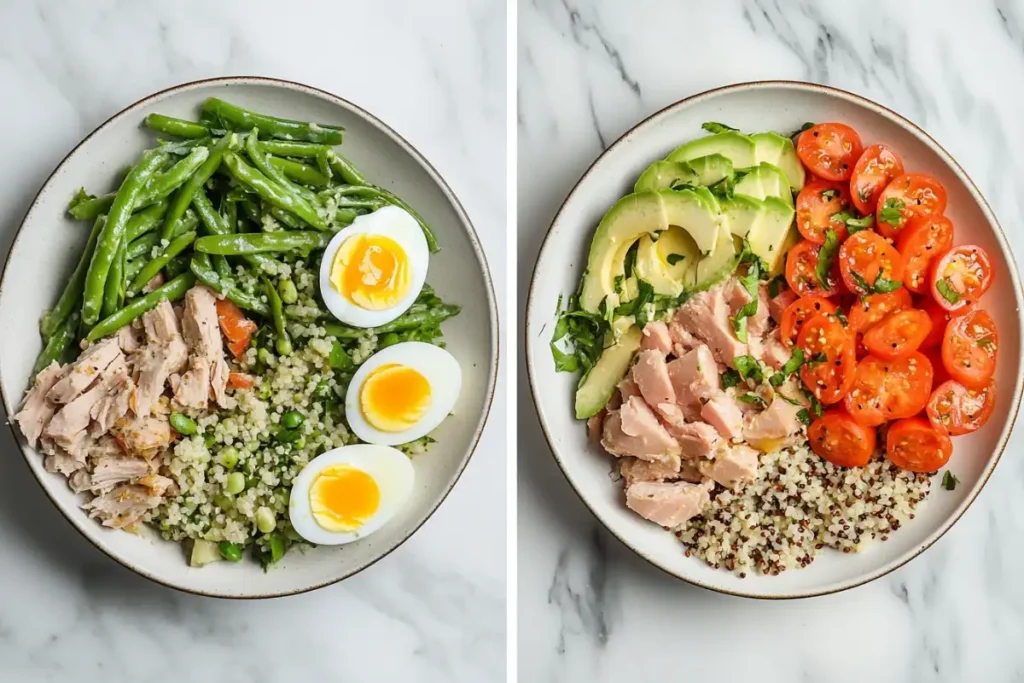Gordon Ramsay’s Culinary Take on Tuna Salad
When it comes to cooking, Gordon Ramsay Tuna Salad is a dish that turns a simple classic into a gourmet treat. His tuna salad is no different, turning this simple dish into a gourmet treat. Unlike a quick, thrown-together lunch version, Ramsay’s recipe uses fresh, top-quality ingredients and smart cooking methods. It’s both fancy and easy to make, ideal for home cooks wanting something special without making it too hard.
Tuna salad might not scream “high cuisine,” but in Ramsay’s hands, it becomes a showstopper. From his use of sustainably sourced tuna to the addition of unexpected flavor boosters like citrus zest and fresh herbs, every element is thoughtfully chosen. This is a salad that doesn’t just satisfy—it wows.
Why Tuna Salad Is a Restaurant Staple
You might be asking, “Why is tuna salad such a hit on restaurant menus?” The answer is simple: it’s flexible, healthy, and a crowd-pleaser. Whether it’s a light starter, a filling main dish, or a tasty side, tuna salad fits the bill. Restaurants love how easy it is to tweak—imagine all the versions, from Niçoise to spicy tuna bowls—and diners enjoy its fresh and simple taste.
Moreover, tuna is rich in protein and omega-3 fatty acids, making it a health-conscious choice. When prepared with a chef’s touch, it becomes a dish that feels both comforting and luxurious. That’s the magic of Ramsay’s approach—he takes this everyday staple and transforms it into something extraordinary.
Who Is Gordon Ramsay’s Tuna Salad Perfect For?
This dish is perfect for anyone who enjoys good food without diving too deep into fancy dining. If you like making restaurant-style dishes at home, Ramsay’s tuna salad is a great choice. It’s also ideal for those who care about fresh, quality ingredients and cooking in a way that’s better for the planet. Whether you’re hosting friends, making a special family meal, or just treating yourself, this tuna salad works for any occasion.
The Unique Touch of a World-Class Chef
What truly sets Ramsay apart is his ability to infuse personality and precision into even the simplest recipes. His tuna salad isn’t just a dish—it’s an experience. By focusing on fresh, seasonal produce and bold, complementary flavors, he ensures that every bite is bursting with taste. Plus, his plating techniques turn a humble salad into a visual masterpiece.
What Sets Gordon’s Recipe Apart from the Rest
Here’s the secret sauce (literally): Ramsay’s recipe combines premium olive oil, tangy citrus zest, and just the right amount of seasoning to let the tuna shine. The addition of crunchy vegetables and a light dressing adds layers of texture and flavor you won’t find in a typical salad.
A Brief History of Modern Tuna Salad Recipes
Tuna salad has been a household favorite for decades, but its origins date back to the early 20th century. Originally, it was a way to repurpose leftover tuna and vegetables. Over time, chefs began experimenting with dressings, textures, and add-ins, evolving the dish into the versatile creation we know today.
The Evolution of Gordon Ramsay’s Style
Gordon Ramsay tuna salad shows his cooking style: bold flavors, top-quality ingredients, and a bit of class. Over time, he has perfected this recipe, proving that simple dishes, when done well, can be truly amazing.
Ingredients in Gordon Ramsay’s Tuna Salad

The ingredients for Gordon Ramsay Tuna Salad include fresh tuna, crisp vegetables, and a light dressing.
Choosing the Right Tuna: Fresh or Sustainable Options
When it comes to crafting the perfect tuna salad, the quality of the tuna is non-negotiable. Gordon Ramsay insists on using the freshest and most sustainable options available, not just for flavor but also for environmental responsibility. Opting for sushi-grade tuna ensures that the fish is safe to eat raw or lightly seared, which is essential for Ramsay’s recipe.
If fresh tuna isn’t easy to find, good-quality canned tuna can be a great substitute, making it perfect for quick lunch ideas. Choose tuna packed in olive oil instead of water for a richer flavor. Also, Picking sustainably sourced tuna—like options certified by the Marine Stewardship Council—helps support healthy oceans. Small choices like this make a big difference.
Signature Add-Ins: Vegetables and Seasonings
Ramsay’s tuna salad isn’t just about the fish—it’s about balance. Vegetables play a starring role, adding freshness and crunch. Think crisp cucumbers, vibrant cherry tomatoes, and finely sliced red onions. These ingredients not only provide contrast in texture but also contribute essential nutrients.
Seasonings are another area where Ramsay’s touch shines. A pinch of sea salt, a dash of freshly cracked black pepper, and a drizzle of extra-virgin olive oil elevate the dish. But it doesn’t stop there—fresh herbs like parsley, dill, or chives are the secret to adding an aromatic quality that makes the salad unforgettable.
The Role of Olive Oil and Citrus Zest
Olive oil is the backbone of Ramsay’s tuna salad dressing. Its fruity, robust flavor complements the fish while also acting as a carrier for other ingredients. Ramsay often pairs olive oil with citrus zest—lemon or lime—because it adds brightness and cuts through the oil’s richness. This combination ensures the salad is light and refreshing, never heavy.
Balancing Texture with Crunchy Additions
Texture is just as important as flavor in a well-made salad. Ramsay includes ingredients like toasted pine nuts, crisp lettuce, or even croutons to give the dish that satisfying crunch. These elements are carefully chosen to balance the tenderness of the tuna and the creaminess of the dressing.
Preparing Gordon Ramsay’s Tuna Salad: Step-by-Step
Creating this dish at home might seem intimidating, but Ramsay’s recipe is surprisingly straightforward. With a little attention to detail, you’ll have a tuna salad that looks and tastes restaurant-quality.
Cooking the Tuna to Perfection: Rare or Seared?

Cooking the tuna for Gordon Ramsay Tuna Salad is key to achieving its perfect flavor and texture. The cooking method for the tuna can make or break this recipe. Ramsay typically sears his tuna, leaving the center rare. This method locks in the fish’s natural juices while creating a flavorful crust. To achieve this, heat a nonstick pan over high heat, brush the tuna steak with olive oil, and season generously. Sear each side for about 1-2 minutes until golden brown but still pink inside.
Alternatively, if you prefer a fully cooked option, opt for a gentle poach in seasoned water. This method ensures the tuna stays moist and tender, perfect for flaking into the salad.
Mixing and Plating for a Visual Feast

Once your tuna is ready, the next step is combining the ingredients. Start with a bed of greens—arugula or spinach works well—then layer in the vegetables. Gently flake the tuna on top, drizzle with dressing, and finish with a sprinkle of herbs or nuts. Ramsay emphasizes the importance of presentation; arranging the salad thoughtfully ensures it looks as good as it tastes.
Nutritional Insights into Gordon’s Recipe
Gordon Ramsay Tuna Salad is a healthy option, packed with omega-3 fatty acids and lean protein. If you’re watching what you eat, Ramsay’s tuna salad is a fantastic option. Each serving is packed with lean protein, healthy fats, and fiber. Tuna itself is an excellent source of omega-3 fatty acids, which support heart and brain health. Adding olive oil provides monounsaturated fats, while the vegetables contribute a range of vitamins and minerals.
For those keeping an eye on calories, portion control is key. Ramsay’s recipe is designed to be satisfying without being overly indulgent, making it a great choice for anyone aiming to eat healthily without sacrificing flavor.
Enhancing Your Tuna Salad the Ramsay Way

To make Gordon Ramsay Tuna Salad even better, experiment with herbs and spices to match your taste.
Flavor Boosters: Herbs, Spices, and Sauces
What sets Ramsay’s tuna salad apart is his creative use of flavor enhancers. Fresh herbs like basil or cilantro can completely change the profile of the dish, adding complexity and depth. Ramsay also isn’t afraid to incorporate bold spices—paprika, cumin, or even a pinch of chili flakes can bring warmth and excitement.
Sauces are another area where Ramsay’s genius shines. A dollop of aioli, a splash of balsamic glaze, or a hint of soy sauce can take the salad in entirely new directions. The key is to experiment and trust your palate.
How Gordon Ramsay’s Recipe Stands Out
A Balance of Simplicity and Sophistication
Gordon Ramsay’s tuna salad is a testament to his ability to transform simplicity into elegance. While tuna salad might sound ordinary, Ramsay’s approach makes it extraordinary. He focuses on using the freshest ingredients, elevating the dish with techniques that prioritize flavor, texture, and presentation. For example, while many recipes rely on heavy mayonnaise-based dressings, Ramsay opts for a lighter vinaigrette that enhances the tuna’s natural flavors rather than overpowering them.
Furthermore, his use of seasonal vegetables, thoughtfully chosen herbs, and premium-quality olive oil sets his recipe apart from the rest. These elements combine to create a dish that’s not only visually stunning but also balanced in taste and texture. The attention to detail, from the searing of the tuna to the careful layering of components, ensures that every bite is a delightful experience.
Why Does Restaurant Tuna Salad Taste Better?
The Importance of Ingredient Quality
One of the primary reasons restaurant tuna salad often tastes superior to homemade versions is the quality of the ingredients used. Restaurants, especially those led by chefs like Ramsay, source the freshest and finest produce available. This means sushi-grade tuna, organic vegetables, and high-quality seasonings are standard. At home, many people use pantry staples or canned goods that, while convenient, don’t deliver the same level of freshness.
In addition to sourcing, restaurants also take care in handling their ingredients. For instance, tuna steaks are often cut to specific thicknesses to ensure even cooking. Vegetables are sliced to uniform sizes, which might seem like a small detail but greatly affects the dish’s texture and balance.
Chef’s Techniques for Flavor Optimization
Another reason for the elevated taste is the techniques chefs use to maximize flavor. Ramsay, for example, sears his tuna at high heat to lock in moisture and create a beautiful crust. Additionally, he emphasizes seasoning at every stage—marinating the fish, dressing the vegetables, and finishing with a sprinkle of sea salt.
Use of Fresh, Seasonal Produce
Ramsay’s commitment to fresh, seasonal produce plays a significant role in the flavor of his tuna salad. Seasonal ingredients are not only more flavorful but also more nutritious. For example, cherry tomatoes at their peak ripeness add a natural sweetness that complements the savory tuna, while freshly picked herbs provide a burst of aroma and brightness.
How Does Paula Deen’s Tuna Salad Compare?
Key Ingredient Differences
Paula Deen’s tuna salad takes a more traditional, Southern-inspired approach compared to Ramsay’s refined European style. While Ramsay’s recipe is light and citrusy, Deen’s is creamier and richer, often incorporating mayonnaise as a primary ingredient. Additionally, Deen’s version might include hard-boiled eggs or sweet pickle relish, which add a different layer of flavor and texture.
Ramsay, on the other hand, avoids these heavier ingredients, opting instead for a lighter dressing made with olive oil and citrus. This fundamental difference reflects each chef’s culinary philosophy: Deen leans into comfort food, while Ramsay emphasizes freshness and finesse.
Unique Aspects of Each Recipe
While both recipes share the base ingredient—tuna—their execution is worlds apart. Ramsay’s dish is built on the principles of balance and minimalism, ensuring that each ingredient shines without overwhelming the others. In contrast, Deen’s recipe is heartier, making it more of a filling meal than a light appetizer or side.
Making Tuna Salad the Martha Stewart Way
Key Techniques in Martha’s Recipe
Martha Stewart’s take on tuna salad is a masterclass in simplicity and elegance, similar to Ramsay’s but with her unique flair. She often incorporates grains like quinoa or farro, which add a nutty flavor and chewy texture. This addition not only makes the salad more substantial but also provides a nutritional boost.
Martha’s technique focuses on gentle mixing to ensure the integrity of the ingredients. Unlike recipes that call for mashing or over-mixing, her approach keeps the tuna in larger flakes, which enhances the overall texture and visual appeal.
How Her Version Aligns with Ramsay’s
Both Stewart and Ramsay prioritize the use of fresh, high-quality ingredients and avoid overly processed components. While their flavor profiles might differ—Ramsay leans towards bold and zesty, and Stewart opts for subtle and earthy—their commitment to culinary excellence is the same. They also share a focus on presentation, recognizing that how a dish looks can be just as important as how it tastes.
Why Gordon Ramsay’s Tuna Salad Is a Benchmark
The comparisons to Paula Deen and Martha Stewart underscore why Ramsay’s tuna salad is in a league of its own. His recipe manages to strike a perfect balance between simplicity and sophistication, making it adaptable for both casual meals and formal occasions. While other chefs might focus on comfort or nutrition, Ramsay’s dish captures the essence of fine dining without losing its accessibility.
While Paula Deen’s recipe is richer, Gordon Ramsay Tuna Salad stands out with its fresh, bold flavors.
FAQs About Gordon Ramsay Tuna Salad
Why Does Restaurant Tuna Salad Taste Better?
Restaurant tuna salad often tastes better because chefs use fresh, high-quality ingredients and precise techniques like seasoning in layers. Additionally, fresh herbs, premium olive oil, and perfectly cooked tuna enhance flavor and texture.
What Type of Tuna Does Gordon Ramsay Use?
Gordon Ramsay typically uses sushi-grade or sustainably sourced fresh tuna. This choice allows him to prepare the fish lightly seared or rare, ensuring a tender texture and rich flavor that elevates the dish.
Can Gordon Ramsay’s Recipe Be Made at Home?
Absolutely! Ramsay’s recipe is designed to be approachable for home cooks. With fresh tuna, seasonal vegetables, and basic pantry staples, you can recreate his signature salad with ease and stunning results.
How Can I Make a Healthier Version?
To make a healthier version, opt for olive oil instead of heavier dressings, include more greens, and skip crunchy toppings like croutons. Adding nutrient-rich vegetables such as kale or spinach boosts both flavor and nutrition.
How Should Tuna Be Cooked for Salad?
Tuna should be seared quickly at high heat for a rare or medium-rare center. This technique preserves its moisture and enhances flavor. Alternatively, poaching ensures tender flakes for those who prefer fully cooked tuna.
Can This Recipe Be Made Gluten-Free or Dairy-Free?
Yes, Ramsay’s tuna salad is naturally gluten-free and dairy-free as long as gluten-containing add-ins like croutons are avoided. Check your seasonings and dressings to ensure they are free from hidden allergens.
How to Store Leftovers Without Losing Flavor?
Store leftover tuna salad in an airtight container in the fridge for up to two days. To maintain freshness, keep the dressing separate and toss just before serving to avoid soggy vegetables.

